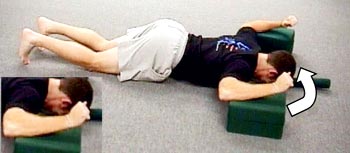Skydiver Description
The Skydiver is an excellent exercise to assist in the recruitment of the spinal extensors. The client can then take advantage of this extension to facilitate improved recruitment of the middle and lower traps and rhomboids. This then positions the glenoid in the scapular plane for improved external shoulder rotation.

The client lays prone, with the forearms resting on pillows or blocks of equivalent height. In some clients, we actually have to start on the floor without the blocks. Other clients we use our therapy pillows at 6 inches from the floor. Place a folded workout towel under their forehead to allow them to keep their face down on the floor. The elbows are flexed to 90 degrees and the shoulder is abducted to 90 degrees.
From here, the client should "tuck" their toes so that the pads of the toes are on the floor. From this position, they will draw their knees slightly along the floor toward the their pelvis. This will cause the hips and knees to flex. This motion will rotate the pelvis anteriorly through engagement of the hip flexors, lumbar extensors and paraspinals. The client will feel as if they are sticking their buttocks up in the air. And they are.
This position with the hips can be held statically while the more dynamic shoulder motion is performed. The client is instructed to rotate the forearms off of the pillows while keeping the elbows down. Be sure the elbows are kept down and not raised with the forearms. This is a significant point to emphasis because keeping the elbows down requires more external rotation at the gleno-humeral joint, which requires greater adduction and depression of the scapulae. The need for greater adduction and depression of the scapulae will require greater involvement of the mid to upper thoracic extensors.
The forearms are then returned to the pillows, the hips maintain the static hold and the shoulder motion is repeated.
As always, keep in mind the type of client that this exercise would apply to. The only way to determine that is through a thorough musculoskeletal assessment. This exercise is not appropriate for individuals with an existing hyperlordosis and/or excessive anterior pelvic tilt. It is also not appropriate for clients with existing rotator cuff issues.
Learn More Corrective Exercises
You can access Function First's complete corrective exercise programs by purchasing Anthony Carey's book, The Pain-Free Program: A Proven Method To Relieve Back, Neck, Shoulder, and Joint Pain. Click here to learn more and to purchase your copy today!